Homer and the Kenai Peninsula, Alaska, USA
29th July - 3rd August 2014
The drive down the west coast of the Kenai Peninsula to Homer rewarded us with stunning scenery in perfect weather. We couldn't have picked a better day!
A lunch break in a roadside layby was a great photo opportunity and suddenly we were joined by Harvey's identical twin. It was wonderful after such a long trip on which we'd seen so few of the little Toyota motorhomes, which become scarcer year on year, to find another one in great condition.
We'd been pointed in the direction of Homer Spit for salmon fishing and grabbed ourselves a beachfront spot for three nights.
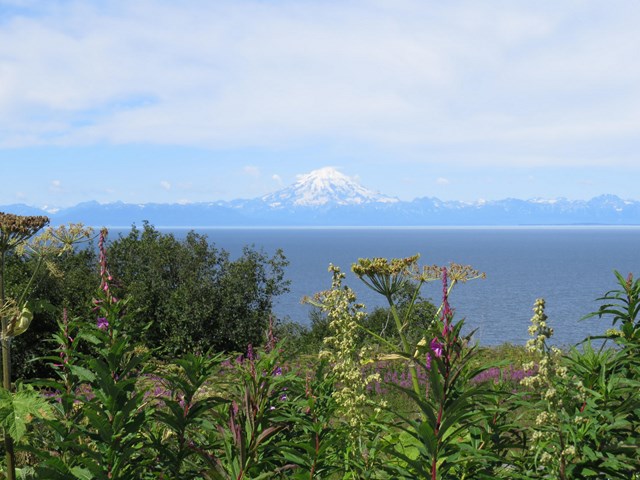
Not
a bad view for lunch!
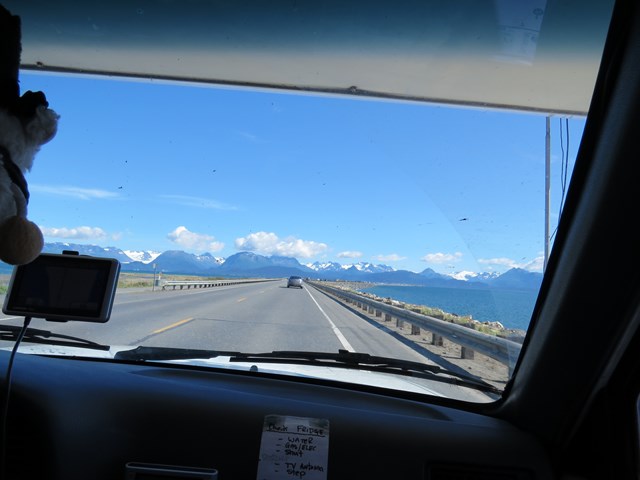
Driving
onto Homer Spit.
Homer Spit, as the name suggested, was a long, low spit of land protruding out from the town of Homer into Kachemak Bay in the Cook Inlet. Home to the small boat harbour, deep water docks and the ferry terminal, the narrow strip of land was lined with galleries showing the work of local artists through the summer. The winter presumably brought much less bustle.
We were camped right next to Homer's famous Fishing Lagoon at the height of salmon season and Phil wasted no time in entering into the spirit of “combat fishing for salmon”, elbow to elbow with the other hopefuls.
We learned that each year young salmon from the hatchery were released to sea from this small lagoon. When they returned to spawn after their years in the ocean, they were drawn back to this spot, offering easy fishing for locals and visitors but also relieving pressure on wild fish in local rivers.
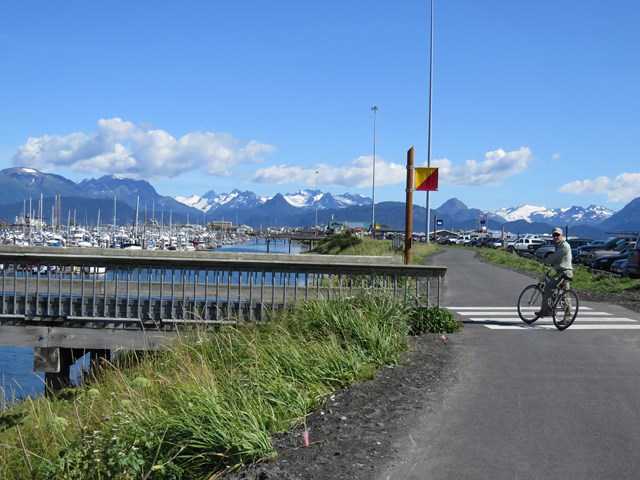
Biking
Homer Spit
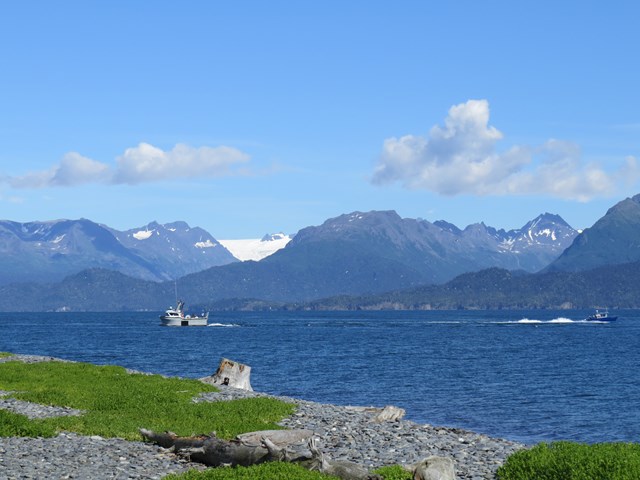
View
from the end of the spit.
The resulting mass of large, returning salmon caused the Nick Dudiak Fishing Lagoon to look as though it was boiling, as countless fish vied for space in the small area of water. We spotted salmon leaping out of the water, in imitation of dolphins. Apparently this action helped the female salmon to push the eggs further down in their bellies, ready for release.
It wasn't long before Phil hooked his first salmon. As the other fishermen were doing, he was using his spinning rod but still had a spot of trouble landing the large fish as the fish battled, tangling him amongst the dense wall of anglers on the shore. Finally the fish was ashore and quickly taken to the fish cleaning station for filleting.
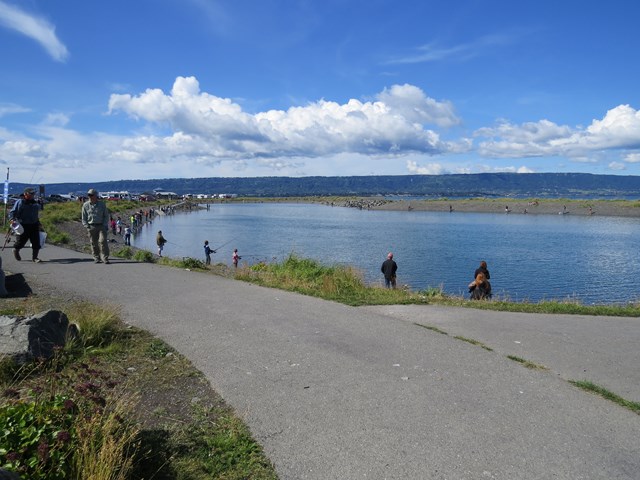
Combat
fishing at Homer Spit Lagoon.
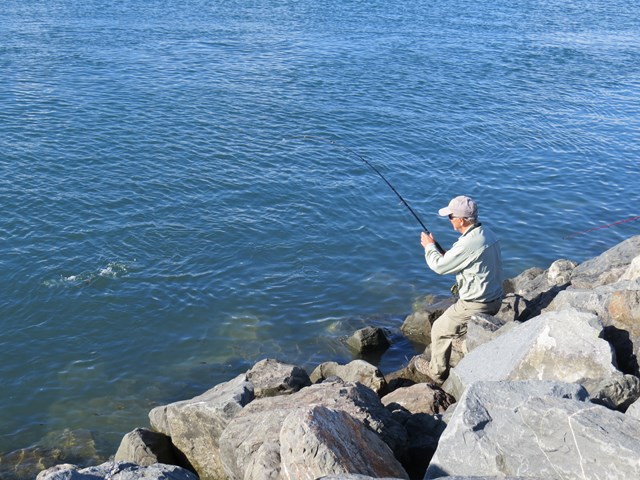
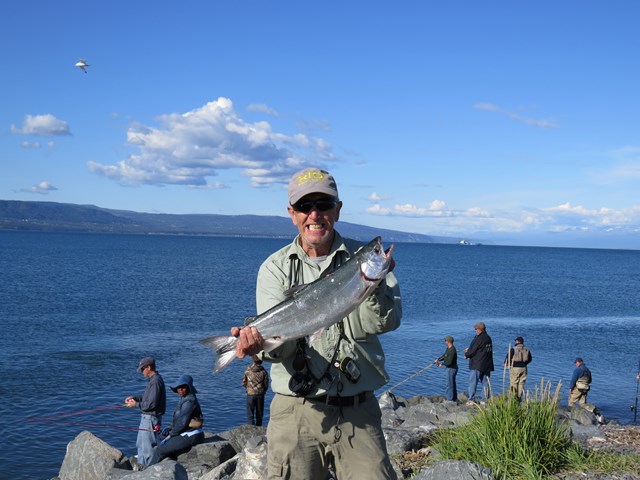
Phil's
first Alaskan Salmon
The salmon here were “silver” or Coho, not the red humpbacked Sockeye we'd spotted heading upstream in the rivers. His first salmon was tasted, the balance frozen and the pressure on our fisherman was somewhat relieved. Now he was determined to have some fun with his fly rod in pursuit of the salmon.
Early next morning Phil and dozens of others were lining the lagoon. This time he was the oddity, using his fly rod, but still managing to catch and release another three, much to the bewilderment of the locals who were eagerly landing their daily bag limit of six each day, to fill their freezers.
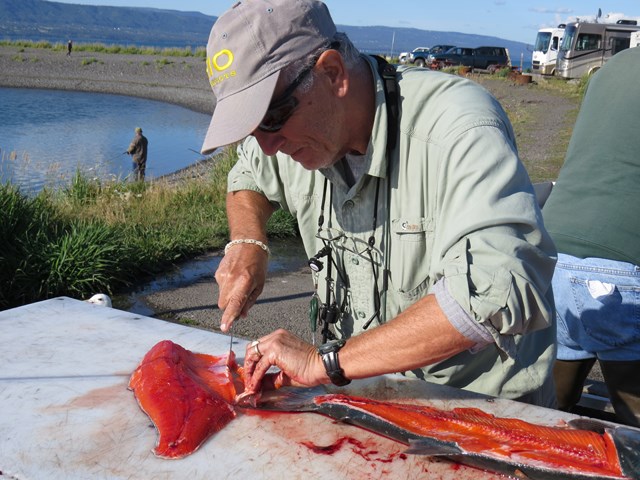
Phil
works on dinner
A bike trip to town and browsing in the Spit's many galleries gave us a break from the fishing, before Phil set out again that evening and landed another nice salmon for our tiny freezer with the fly rod. Unfortunately two salmon was about all our small ice box on Harvey could accommodate, even after a serious ice lolly eating session! All the rest of his catch in Homer would have to be released for someone else to re-catch and freeze.
Even in the next morning's dense fog, Phil managed to hook about 12 salmon and land four, losing a lot of fishing gear in the process as the large fish would often snap his 8lb line.
We left Homer, glad that the weather had been kind, allowing us to enjoy the beautiful views for two days of our visit.
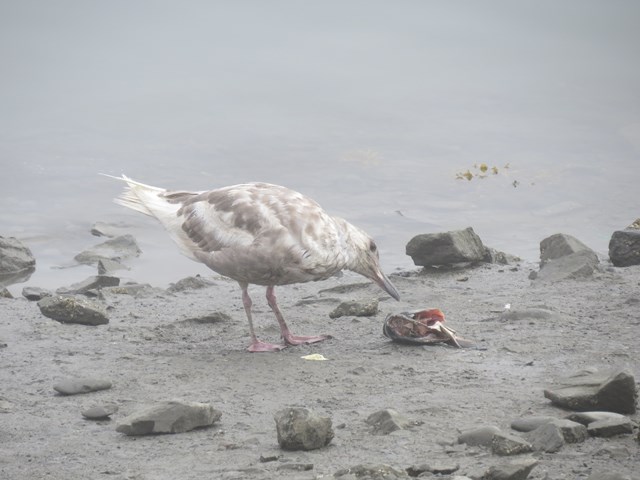
Somebody
else enjoying the catch.
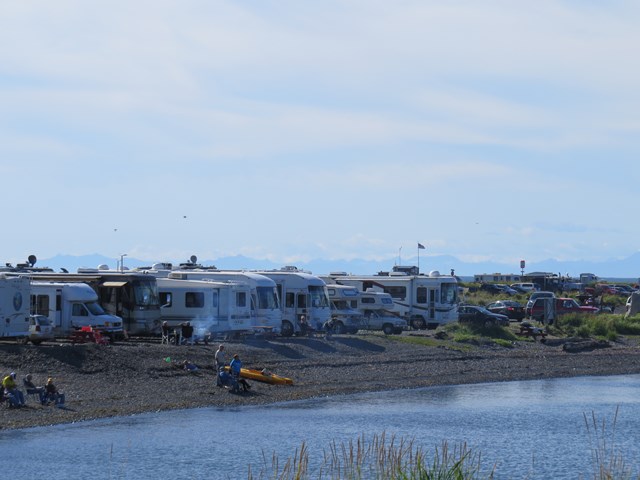
Little
Harvey playing with the big boys at his beachfront spot.
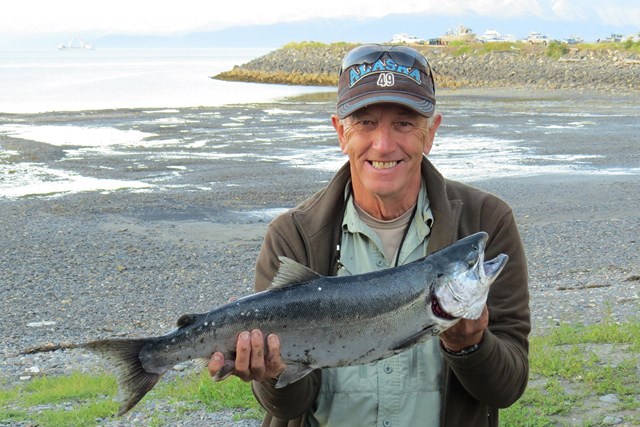
OK,
the freezer is full now and I can't manage another ice lolly!
We had been pointed in the direction of Anchor Point and helpful Grant at the tiny “Fly Box” tackle shop, which itself was not much bigger than a tackle box, advised Phil where to fish and what type of gear to use. He even rented him a pair of wading boots. Despite Phil being the owner of three pairs of boots himself, all were felt-soled, a type not allowed in Alaska so here, as in the Russian River, he'd been forced to hire boots.
Anchor Point was a gorgeous spot and we immediately checked into the campground at Slidehole for three days, conscious of the weekend bearing down on us.
The first afternoon fishing the Anchor River didn't bring much success, with Phil landing only one trout but at least that was on a home-made fly, a first!
Meanwhile Christine biked to the nearby beach and whilst trying to rendez-vous with Phil on the river, almost ended up stuck in a bog! Muddy but happy, she returned to camp, an enormous bald eagle flight feather the result of her treasure hunting trip. Quickly she dragged Phil on his bike back to the beach to enjoy the view. From the beach the views of distant Mount Redoubt in the Lake Clark National Park were stunning. Unfortunately we were unable to get a closer look, as the whole peninsula was accessible only by boat or plane.
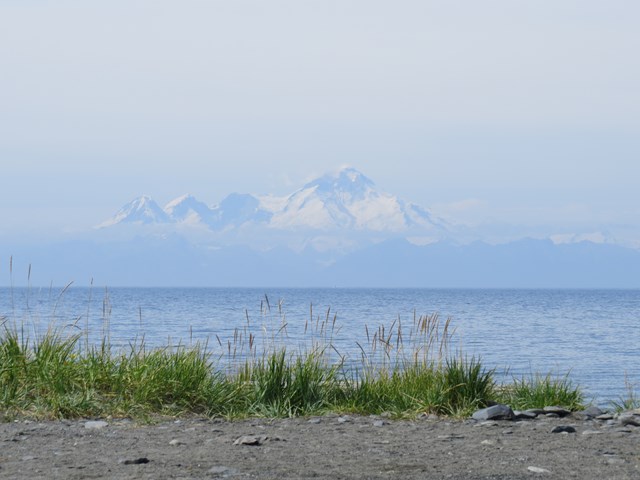
Gorgeous
Anchor Point
We'd picked up some firewood at the local grocery store but it proved to be so damp that all we achieved was to create a large cloud of smoke and infuse our clothes with the smell of smouldering wood. We noticed that our neighbours, locals from Anchorage, took their pickup truck to the beach each day and loaded it with driftwood to burn. Their fire was permanently ablaze and we resolved to gather our own driftwood fuel the next day.
Anchor Point acquired it's name from a visit by Captain James Cook, who was seeking the Northwest Passage. In this spot he lost a large anchor to powerful tidal currents, giving the spot its name.
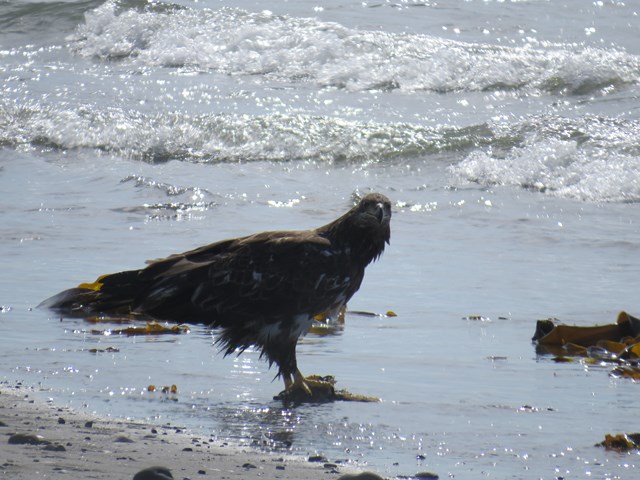
Baby
Bald Eagle learning how to scavenge fish carcasses on the beach.
Next morning we went to investigate the South Fork of the Anchor River, further inland, which we had been advised was a great river to fish. However, a combination of major roadworks and a lack of parking spaces big enough for Harvey, left us disappointed.
For a few minutes we debated packing up camp and moving on, however the beauty of Anchor Point helped us to resolve to stay. Phil set off with renewed determination to hunt Dolly Varden in the river near the campground. This time his luck was in. He had managed to work out what attracted the Dolly's and hooked more than twenty during the afternoon.
Meanwhile Christine enjoyed more beach-combining, returning with another huge bald eagle flight feather and a bag full of driftwood. Now she just had to head down to the river to drag the angler back home to enjoy the fire. Down at the river, the resident bald eagles were busy. We spotted three in flight. One obviously had a favourite perch on a dead tree on the river bank. We watched the local ravens mobbing him where he sat, displaying complete indifference to their attack. A while later he suddenly took flight, dived into the river near Phil's fishing spot, grabbed himself a fish and flew right over our heads with it.
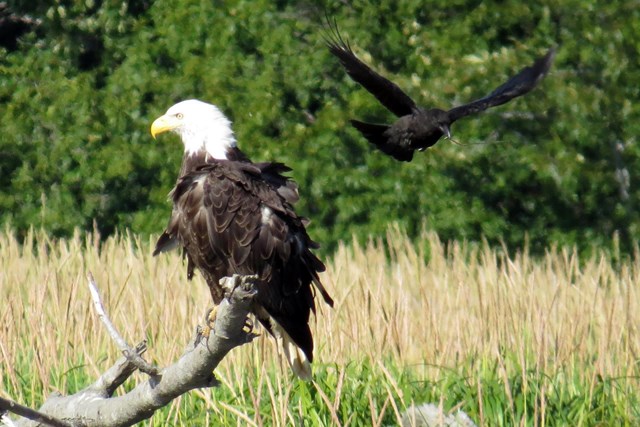
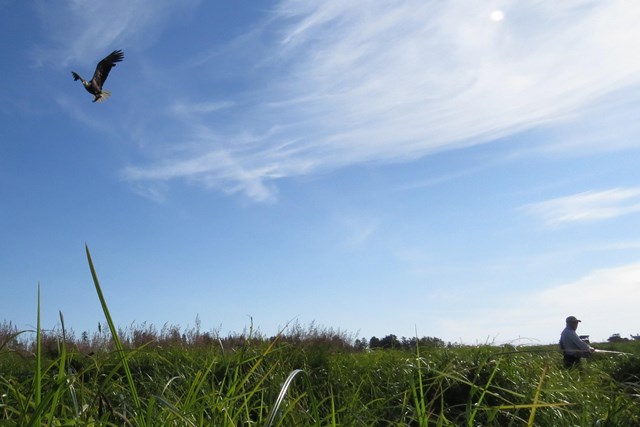
“Hey
that pesky eagle just nicked my fish!”
Anchor Point's claim to fame, apart from stealing Captain Cook's best anchor, was that it was the most westerly point accessible by continuous highway in the USA.
On our next beach visit to collect firewood the next day, we posed beside the sign, wondering if we'd travelled the most easterly highway in the country too. It was pretty likely!
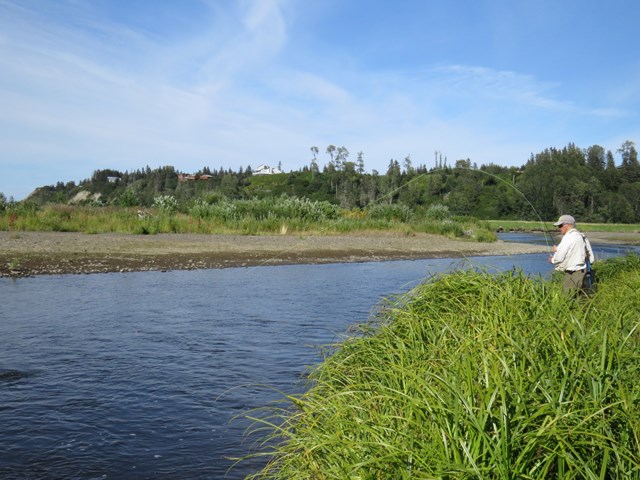
Fishing
for Dolly Varden on the Anchor River
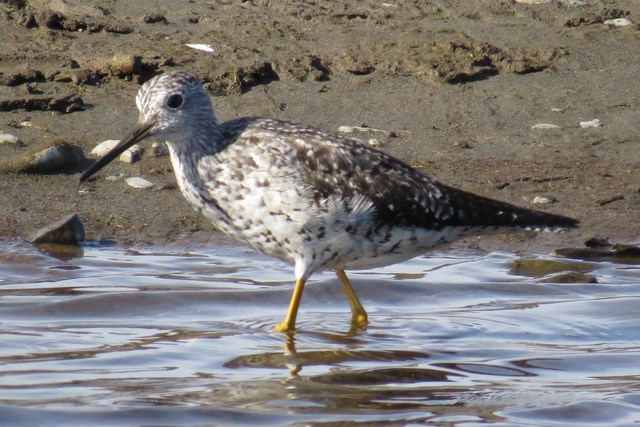
It was lucky that we'd collected a bag of firewood each this time, as back at the campground we met Cata and Mariano from Argentina, on their honeymoon in Alaska for a spot of fishing.
Phil was able to show them the best fishing spot and the three of them spent the evening fishing together and catching plenty of Dolly Varden.
Cata and Mariano joined us by the campfire later, introducing us to the traditional Argentinian “Mate” tea.
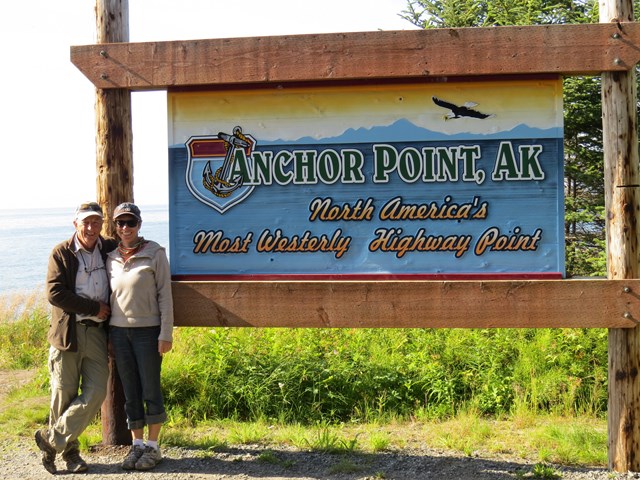
Mate tea was produced from the leaves of a South American herb. here was ritual involved in it's preparation and serving. Everyone shared the same traditional cup, fashioned from a gourd. One person was responsible for topping up the tea leaves with more hot water and each person drank in turn, handing the gourd back to the server when they had taken enough and only thanking the server if they had drunk enough and didn't want any more on the next round of the cup. The tea was drunk through an intriguing metal straw, which also served as a filter for the tea leaves.
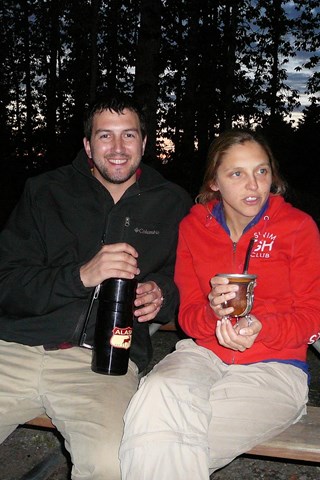
Mariano
and Cata prepare the Mate tea.
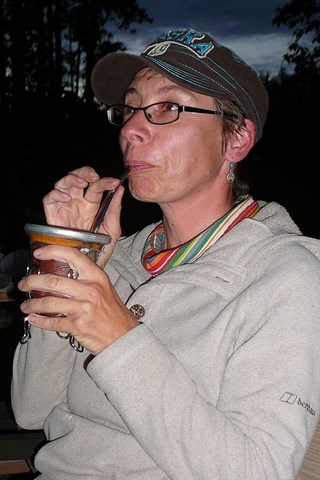
Christine
enjoys the herbal tea.

Fishing
for Dollies on the Anchor River
Our friends assured us that the tea was entirely herbal and without caffeine but we later learned that Mate tea contained as much caffeine as found in coffee but also extra stimulants found in tea and chocolate. A triple whammy! Perhaps this was the reason we were up talking late into the night, succeeding for the first time in Alaska in staying awake until it finally went dark, at around half past midnight! For Christine, who had been on a strict caffeine-free diet for several years, this was to be a sleepless night!
Another interesting feature at Anchor Point was the boat launch from the beach by tractor. We watched with fascination as a tractor would hook up the trailer of an incoming fishing boat and head down into the water to await their arrival.
The boats returned from their fishing trips at full tilt, only hitting reverse as they entered the submerged trailer and as soon as they were secured, the tractor hauled them up the deep sand of the beach. The whole operation took no time at all but we decided that we definitely prefer the travel lift for Anju!
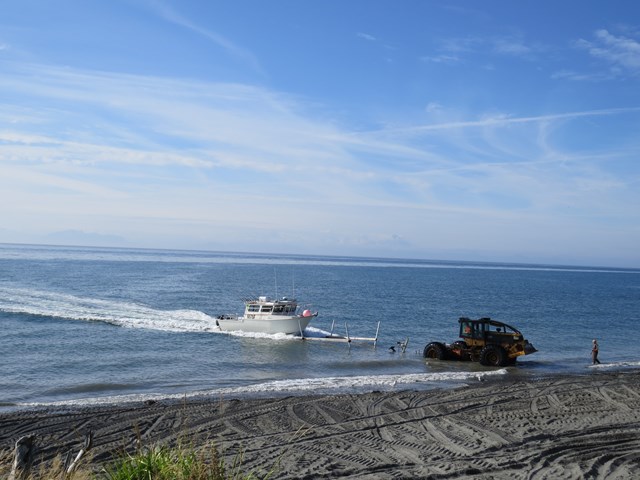
Hit
the brakes!
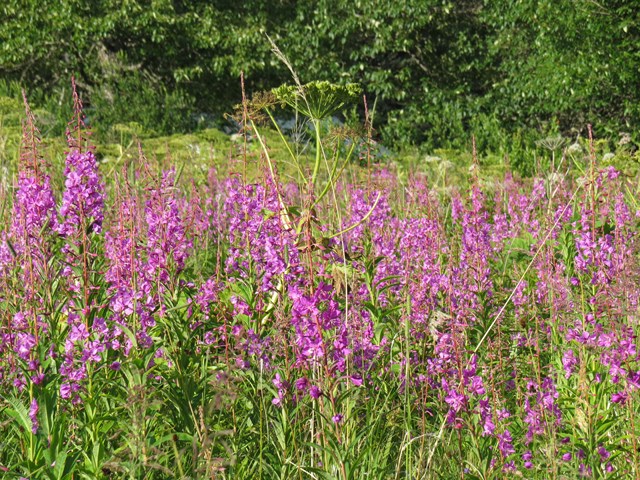
Alaska's
colourful and abundant fireweed.
We made one last stop on the Kenai Peninsula back at Crescent Creek, so that Phil could again try out his Dolly Varden huntng skills there before starting to head back to the “civilisation” of the city of Anchorage, ready to head north.